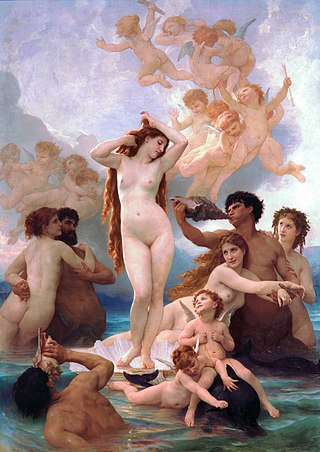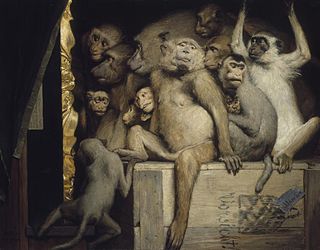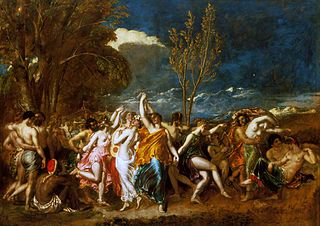
Henri-Robert-Marcel Duchamp was a French painter, sculptor, chess player, and writer whose work is associated with Cubism, Dada, and conceptual art. He is commonly regarded, along with Pablo Picasso and Henri Matisse, as one of the three artists who helped to define the revolutionary developments in the plastic arts in the opening decades of the 20th century, responsible for significant developments in painting and sculpture. He has had an immense impact on 20th- and 21st-century art, and a seminal influence on the development of conceptual art. By the time of World War I, he had rejected the work of many of his fellow artists as "retinal", intended only to please the eye. Instead, he wanted to use art to serve the mind.

An art museum or art gallery is a building or space for the display of art, usually from the museum's own collection. It might be in public or private ownership, be accessible to all, or have restrictions in place. Although primarily concerned with visual art, art museums are often used as a venue for other cultural exchanges and artistic activities, such as lectures, jewelry, performance arts, music concerts, or poetry readings. Art museums also frequently host themed temporary exhibitions, which often include items on loan from other collections.

Varnish is a clear transparent hard protective coating or film. It is not to be confused with wood stain. It usually has a yellowish shade due to the manufacturing process and materials used, but it may also be pigmented as desired. It is sold commercially in various shades.

Academic art, academicism, or academism, is a style of painting and sculpture produced under the influence of European academies of art. This method extended its influence throughout the Western world over several centuries, from its origins in Italy in the mid-16th century, until its dissipation in the early 20th century. Its reached its apogee in the 19th century, after the end of the Napoleonic Wars in 1815. In this period, the standards of the French Académie des Beaux-Arts were very influential, combining elements of Neoclassicism and Romanticism, with Jean-Auguste-Dominique Ingres a key figure in the formation of the style in painting. The success of the French model led to the founding of countless other art academies in several countries. Later painters who tried to continue the synthesis included William-Adolphe Bouguereau, Thomas Couture, and Hans Makart among many others. In sculpture, academic art is characterized by a tendency towards monumentality, as in the works of Auguste Bartholdi and Daniel Chester French.

William Powell Frith was an English painter specialising in genre subjects and panoramic narrative works of life in the Victorian era. He was elected to the Royal Academy in 1853, presenting The Sleeping Model as his Diploma work. He has been described as the "greatest British painter of the social scene since Hogarth".

Decoupage or découpage is the art of decorating an object by gluing colored paper cutouts onto it in combination with special paint effects, gold leaf, and other decorative elements. Commonly, an object like a small box or an item of furniture is covered by cutouts from magazines or from purpose-manufactured papers. Each layer is sealed with varnishes until the "stuck on" appearance disappears and the result looks like painting or inlay work. The traditional technique used 30 to 40 layers of varnish which were then sanded to a polished finish.

The Summer Exhibition is an open art exhibition held annually by the Royal Academy in Burlington House, Piccadilly in central London, England, during the months of June, July, and August. The exhibition includes paintings, prints, drawings, sculpture, architectural designs and models, and is the largest and most popular open exhibition in the United Kingdom. It is also "the longest continuously staged exhibition of contemporary art in the world".

The Salon, or rarely Paris Salon, beginning in 1667 was the official art exhibition of the Académie des Beaux-Arts in Paris. Between 1748 and 1890 it was arguably the greatest annual or biennial art event in the Western world. At the 1761 Salon, thirty-three painters, nine sculptors, and eleven engravers contributed. From 1881 onward, it was managed by the Société des Artistes Français.

Art criticism is the discussion or evaluation of visual art. Art critics usually criticize art in the context of aesthetics or the theory of beauty. A goal of art criticism is the pursuit of a rational basis for art appreciation but it is questionable whether such criticism can transcend prevailing socio-political circumstances.
From the seventeenth century to the early part of the twentieth century, artistic production in France was controlled by artistic academies which organized official exhibitions called salons. In France, academies are institutions and learned societies which monitor, foster, critique and protect French cultural production.

The Macchiaioli were a group of Italian painters active in Tuscany in the second half of the nineteenth century. They strayed from antiquated conventions taught by the Italian art academies, and did much of their painting outdoors in order to capture natural light, shade, and colour. This practice relates the Macchiaioli to the French Impressionists who came to prominence a few years later, although the Macchiaioli pursued somewhat different purposes. The most notable artists of this movement were Giuseppe Abbati, Cristiano Banti, Odoardo Borrani, Vincenzo Cabianca, Adriano Cecioni, Vito D'Ancona, Serafino De Tivoli, Giovanni Fattori, Raffaello Sernesi, Silvestro Lega, and Telemaco Signorini.
Vasile Hutopila is a contemporary Romanian painter of Ukrainian ethnicity. His works belong to impressionism.
Cinq à sept is a French-language term for activities taking place after work and before returning home, or having dinner.

A private view is a special viewing of an exhibition by invitation only, often an art exhibition and normally a preview at the start of a public exhibition. In the United Kingdom, a private view is generally open to all visitors. Typically wine and light refreshments are served in the form of a reception. If the works on show are by a living artist, it is normal for them to attend the private view. Artworks on view are typically for sale.

An exhibition, in the most general sense, is an organized presentation and display of a selection of items. In practice, exhibitions usually occur within a cultural or educational setting such as a museum, art gallery, park, library, exhibition hall, or World's fairs. Exhibitions can include many things such as art in both major museums and smaller galleries, interpretive exhibitions, natural history museums and history museums, and also varieties such as more commercially focused exhibitions and trade fairs. They can also foster community engagement, dialogue, and education, providing visitors with opportunities to explore diverse perspectives, historical contexts, and contemporary issues. Additionally, exhibitions frequently contribute to the promotion of artists, innovators, and industries, acting as a conduit for the exchange of ideas and the celebration of human creativity and achievement.

Yerevan Vernissage is a large open-air market in Yerevan, Armenia. The name of the market is the derived from the French word vernissage. The market lies along Aram Street and Buzand Street at a length of 350 metres (1,150 ft), connecting the Hanrapetutyun street with the Khanjyan street. The market mainly features a collection of different types of traditional Armenian art works.

A paintings conservator is an individual responsible for protecting cultural heritage in the form of painted works of art. These individuals are most often under the employ of museums, conservation centers, or other cultural institutions. They oversee the physical care of collections, and are trained in chemistry and practical application of techniques for repairing and restoring paintings.

Painterly Realism of a Peasant Woman in Two Dimensions, also known as Red Square, is a 1915 painting by Kazimir Malevich. Red Square was part of Malevich's Suprematist art movement (1915-1919), which aimed to create artworks that were universally understood.

The World Before the Flood is an oil-on-canvas painting by the English artist William Etty, first exhibited in 1828 and currently in the Southampton City Art Gallery. It depicts a scene from John Milton's Paradise Lost in which, among a series of visions of the future shown to Adam, he sees the world immediately before the Great Flood. The painting illustrates the stages of courtship as described by Milton; a group of men select wives from a group of dancing women, drag their chosen woman from the group, and settle down to married life. Behind the courting group, an oncoming storm looms, foreshadowing the destruction which the dancers and lovers are about to bring upon themselves.

An art gallery is a room or a building in which visual art is displayed. In Western cultures from the mid-15th century, a gallery was any long, narrow covered passage along a wall, first used in the sense of a place for art in the 1590s. The long gallery in Elizabethan and Jacobean houses served many purposes including the display of art. Historically, art is displayed as evidence of status and wealth, and for religious art as objects of ritual or the depiction of narratives. The first galleries were in the palaces of the aristocracy, or in churches. As art collections grew, buildings became dedicated to art, becoming the first art museums.


















